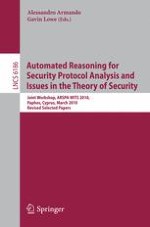2010 | Buch
Automated Reasoning for Security Protocol Analysis and Issues in the Theory of Security
Joint Workshop, ARSPA-WITS 2010, Paphos, Cyprus,March 27-28, 2010. Revised Selected Papers
herausgegeben von: Alessandro Armando, Gavin Lowe
Verlag: Springer Berlin Heidelberg
Buchreihe : Lecture Notes in Computer Science
